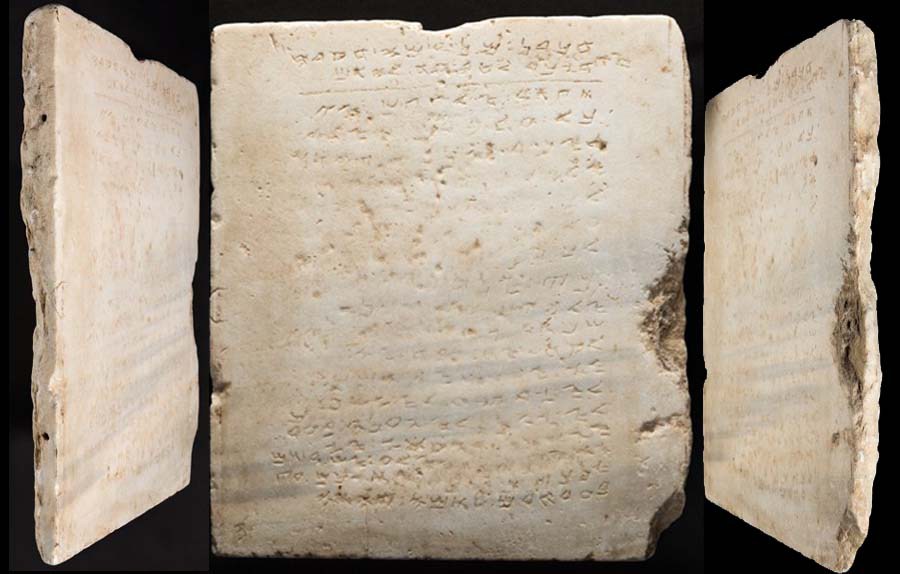The world’s earliest known stone inscription of the 10 commandments was sold at auction on November 16, 2016 after spending three decades as a paving stone. According to Heritage Auctions, this tablet written in Samaritan is “uniquely important to many different faiths and cultures.” The Commandments were carefully chiseled into the white marble slab, weighing 52 Kilos (115 lbs) and measuring 63 by 57 centimeters.
The tablet was likely inscribed during the late Roman or Byzantine era between 300 and 800 AD; making the tablet about 1,500 years old. It is thought to have marked the entrance of an ancient synagogue that was later destroyed by the Romans between 400 and 600 AD, or by the Crusaders in the 11th century, as noted by the Heritage Auctions.
For I am the Lord who brought you up out of the land of Egypt to be your God. You shall therefore be holy, for I am holy
.– Leviticus 11:45 (ESV)

The tablet was found and recovered during an excavation for a railroad line near the modern city of Yavneh in Western Israel. After its discovery in 1913, it was used as a paving stone in a private courtyard, which subsequently may have caused the wearing on the surface. According to David Michaels, Director of Ancient Coins for Heritage Auctions, “The workmen who found it did not recognize its importance and either sold or gave it to a local Arab man, who set the stone into the threshold of a room leading to his inner courtyard with the inscription facing up.” However, other reports say that he had the engraving concealed. The Arab man later sold it to Y. Kaplan, a municipal archaeologist in 1943, who owned it until he passed away in 2000.
According to Michaels, Kaplan “immediately recognized its importance as an extremely rare ‘Samaritan Decalogue,’ one of five such known stone inscriptions that date to the late Roman-Byzantine era (300-640 AD) or just after the Muslim invasion of the seventh century AD.” Deutsch purchased the piece with other scholars for research and study, and later obtained it for his Living Torah Museum in Brooklyn, NY in 2005. It has been the centerpiece of the Museum’s collection since and was subsequently published in Biblical Archaeology Review magazine and other publications. Later in 2005, The Israel Antiquities Authority approved the export to the United States.
As noted by Heritage Auctions, “After an introductory dedication and invocation, the tablet lists nine of the 10 commonly known Biblical Commandments from the Book of Exodus, omitting “Thou shalt not take the name of the Lord thy God in vain” (King James translation), and adding one commonly employed by the Samaritan sect exhorting worshippers to “raise up a temple” on Mount Gerizim, the holy mountain of the Samaritans, located near the West Bank city of Nablus.” The full inscription of the tablet is listed on the Heritage Auction website and varies from the original Biblical Commandments.
And God spoke all these words, saying, “I am the Lord your God, who brought you out of the land of Egypt, out of the house of slavery.
– Exodus 20: 1-2 (ESV)

The tablet was put up for sale by Rabbi Shaul Deutsch, at the recent public auction of Ancient Biblical Archaeology Artifacts. While the tablet sold to a private buyer, the Dallas-based auctioneer, Heritage Auctions, stated that the buyer must display the piece in a public museum. The auction opened with a $300,000 bid and sold for $850,000 to a buyer that prefered to remain anonymous.
Seeing old inscriptions like this is quite intriguing and brings to mind many questions. When were the original Ten Commandments and Torah written? Was there even an alphabet available at the time of the Exodus and did it differ from modern Hebrew? When did different versions such as this one start showing up? And what impact did these writings have on the world? These are just a few of the many important questions debated in academic circles today and they will all be explored in upcoming installments of Patterns of Evidence.
TOP PHOTO: Three views of the Ten Commandments marble slab. (Heritage Auctions)



